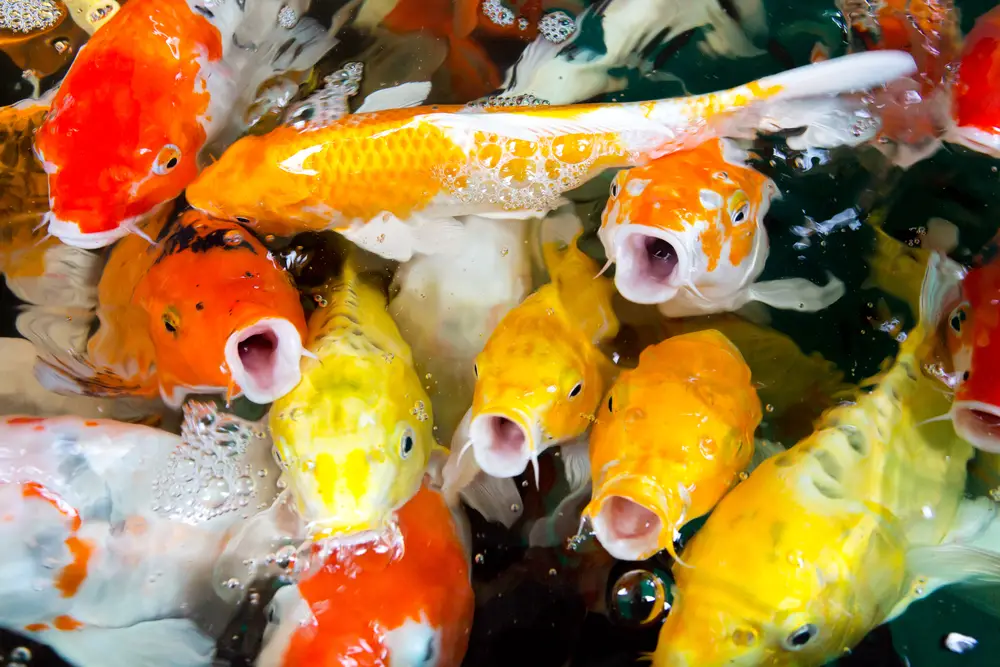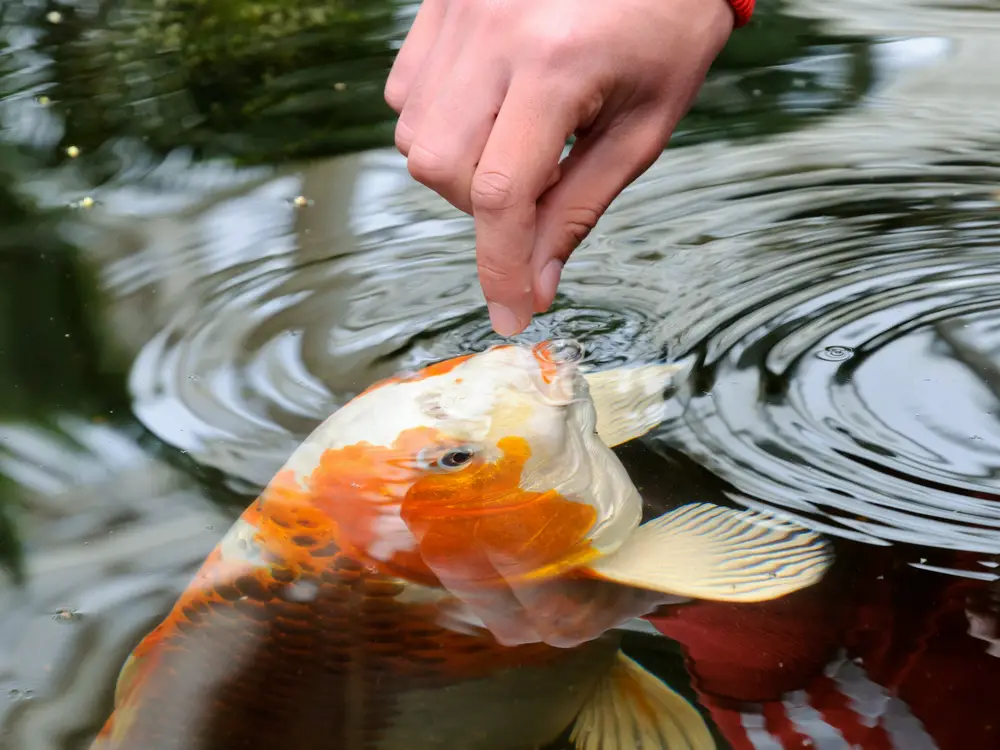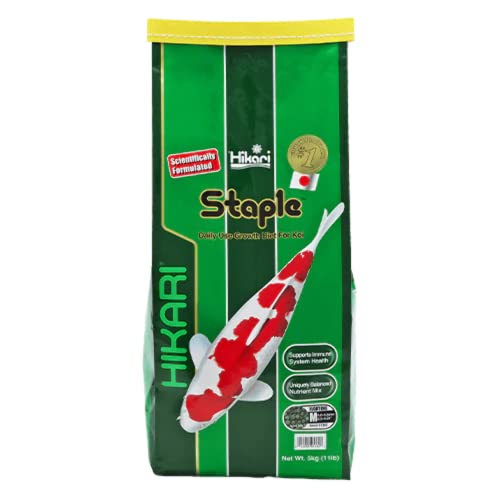Koi fish are favorites of most people who keep ponds or aquariums in their homes. Because of their vibrant colors, these fish are almost as popular as goldfish for decoration purposes. If you’re thinking about buying one or a few for your fish tank, you might be asking, “what do koi fish eat?”

In this article, we’ll discuss what koi fish normally eat in the wild. We’ll also address what you can feed them and what you shouldn’t, and answer more questions that may be on your mind.
Let’s dive in!
Table of Contents
What Do Koi Fish Eat in Nature?
Koi fish descend from common carp. Therefore, if you release them into their natural habitats, those who’ll manage to survive will feed on anything that common carp will eat.
Namely, koi fish will feast on algae, seeds, vegetation, larvae, insects, crustaceans, or worms. Basically, they’ll eat anything they’ll stumble upon at the bottom of a pond. They’ll also hunt at the pond’s surface for any potential food source.
Now that you have a general idea of what koi fish eat, let’s find out what you can feed them if you have them as pets.
What to Feed Your Koi Fish
As you’ve probably noticed, the diet of koi fish can be pretty versatile. Luckily, this gives you a wide array of food options that you could provide for your fish so that they’ll remain healthy and happy.
1. Brine Shrimp
- NUTRITIOUS TREAT: Freeze-Dried Brine Shrimp are an excellent high-protein treat for all freshwater and saltwater fish
- HIGH QUALITY INGREDIENTS: Made with the highest quality brine shrimp available, this product is rich in vitamins and minerals
- SAFE ALTERNATIVE: Freeze-dried brine shrimp are just as nutritious as live food, without the risk of bacteria or parasites
- INSTRUCTIONS: Feed as a part of a varied diet, which should include at least one Omega One staple food. Feed daily, using only as much food as fish can consume in two minutes
- GUARANTEED ANALYSIS: Min Crude Protein 48% / Min Crude Fat 6% / Max Crude Fiber 2.5% / Max Moisture 5%
Last update on 2025-03-28 / Affiliate links / Images from Amazon Product Advertising API
Brine shrimp is a great source of nutrients that your koi fish can benefit from. For that reason, it’s one of the best meals that you can give to newly hatched koi fish.
What makes brine shrimp so special is that it’s a simple definition of bio-enrichment. In other words, the nutrients that the shrimp will gain after feeding will quickly pass to your little koi fish.
Even better, because of the shrimp’s small size, you won’t have to worry about your fish eating too much of them.
2. Spirulina Algae
No products found.
Spirulina algae, also known as cyanobacteria, is a type of algae that lives in lakes that have hard water and high pH levels. It’s a small alga, and it usually grows until it’s only half a millimeter in length.
This alga is another favorite of koi fish owners to give their pets because it’s packed with benefits, such as:
- Improves digestive health
- Helps prevent swollen abdomens
- Enhances the functions of the immune system
- Gives the fish better coloration thanks to the carotenoids that it includes
- Encourages growth
- Boosts the production of enzymes that quickly turn fats into energy
3. Fish Food
Another alternative is good ol’ fish food, and you’ll find plenty of market options that are made specifically for koi fish.
Smaller and baby koi fish are the best candidates for flake fish food, which is the tiniest type out there. On the other hand, pellets should be more satisfactory for an average-sized koi fish. Fish food bars should work just great for larger, fully grown koi fish.
What makes fish food a wonderful choice is that it’s usually rich in protein, low in fat, and has all the essential nutrients and vitamins that your koi will need.
4. Wheat Germ
- Made for cooler climates that experience a winter season
- Floating pellets allow easy monitoring of amount eaten
- High in stabilized vitamin C
- Improves brilliance and luster to skin
- Provides superior growth rates
Last update on 2025-03-28 / Affiliate links / Images from Amazon Product Advertising API
Although some people might be skeptical about this food because of its name, it’s not the bad kind of germ. On the contrary, wheat germ refers to the part of wheat that produces sprouts and grows into a new plant.
Feeding your fish wheat germ can increase their growth rate. Wheat germ includes vitamin E, which can further improve the health of your koi.
- Promotes balanced growth
- Boosts oxygen and nutrient flow
- Enhances blood circulation
- Helps fight off different diseases
Besides the types of food we’ve mentioned, you could also give your koi fish:
- Clams
- Worms
- Larvae
- Shrimp
- Tadpoles
High-Quality Products to Feed Your Koi Fish
If you’re not enthusiastic about feeding your fish worms or larvae, your best bet is to switch to fish food that you can order. There are many top-quality options out there to match every budget.
Below are some of our favorites!
1. Hikari Staple Blend Fish Food
- This product is easy to use
- This product adds a great Value
- This product is Manufactured in japan
Last update on 2025-03-28 / Affiliate links / Images from Amazon Product Advertising API
This economical blend is a great option for everyday feeding. Better yet, the Hikari blend is suitable for all life stages, and it’s made especially for medium-sized koi fish, as well as other pond fish.
Still, the best thing about this fish food is that it has a just-right amount of vitamin C. As a result, it can improve the fish’s resistance to disease and stress.
2. TetraPond Variety Blend Fish Food
- POND BLEND: Daily staple food for koi, ornamental goldfish and other pond fish species of all sizes – enhances color and vitality.
- VARIED DIET: This blend includes Pond Sticks, Koi Vibrance and Spring & Fall Diet.
- SOFT STICKS: Easy to eat and digest for both small and large fish.
- COLOR-ENHANCING: Nutrition to enhance color and vitality.
- A premium blend of three foods to enhance vitality
Last update on 2025-03-28 / Affiliate links / Images from Amazon Product Advertising API
Another awesome koi fish food you can go for is this TetraPond blend. Not only is it healthy and tasty, but it’s also made to enhance the colors and appearance of your fish. Who wouldn’t want a vibrant pond in their backyard?
Plus, the TetraPond food is easy to munch on and digest by small and large species. It contains wheat germs, and we’ve already discussed the awesome effects it can have on your koi fish!
3. TetraPond Koi Vibrance
- KOI POND NUTRITION: An ideal maintenance diet for your koi, ornamental goldfish and other outdoor fish species.
- DAILY DIET: Provides nutrition for energy, longevity and overall health.
- SOFT STICKS: Floating sticks are easy for fish to eat and digest.
- CLEAR WATER: Feeding a high-quality, highly digestible food creates less waste for clearer water.
- USAGE: Feed daily when water temperatures are above 50 degrees.
Last update on 2025-03-27 / Affiliate links / Images from Amazon Product Advertising API
We can’t talk about koi fish food without mentioning the market leader, which is TetraPond Koi Vibrance. Although this popular choice is a bit pricier than most fish food brands, a lot of users consider it their number one option.
This is due to the formula’s richness in nutrients, which boosts growth, longevity, and energy. Also, the sticks of the Koi Vibrance are soft enough for all fish sizes to eat and digest.
What to Avoid Feeding Your Koi Fish

We’ve gone through a koi fish’s preferred choices when it comes to food, but what about all the food items that you’re not allowed to give to your fish?
First of all, steer clear of anything high in carbs. Koi fish can’t digest carbs easily, and eating more than 10% of carbs per day could lead to numerous digestive system issues. For that reason, stay away from white bread, corn, and peas.
Grains aren’t recommended for koi, either, since they’re essentially filler foods. If you must give your koi rice or pasta, at least make sure to cook them without salt. This way, they won’t expand inside your fish.
It’s worth mentioning that feeding your koi grains may be beneficial if they’ve started losing weight. Just ensure that these grains aren’t the base of your fish’s diet.
Another thing to avoid feeding your koi fish is anything you’ve captured in the wild. Don’t give them any types of frogs, fish, or bugs since they might be carrying a parasite or disease.
Koi Fish Feeding Tips For Beginners
If you haven’t kept a goldfish or koi fish before, you might use some extra help to learn how to feed these beautiful creatures. Here are a few guidelines to follow:
- Feed your koi fish as often as four times a day
- Let the fish eat as much as they can within a five-minute timeframe
- Remove any food that remains so that it won’t break down and affect the water quality
- Don’t feed your fish before storms because the oxygen levels tend to be low when it rains
- Koi fish need oxygen to digest their food, so make sure that the feeding time is right
- Consistently feed your koi fish so that they’ll recognize your face and greet you
- Give your koi more carbohydrate-rich foods around early spring and late fall
- Feed your koi high-protein diets in early summer since it’s the beginning of the mating season
- Reduce the amount of koi food in winter because their metabolism slows down greatly
- Don’t give your koi fish food if the pump breaks because they’ll need oxygen to digest it
How Long Can Koi Fish Go Without Food?
Remember how we pointed out that koi fish were low-maintenance? Well, these fish can survive for two whole weeks without food.
They’ll simply feed on anything they come across inside their pond or tank such as algae and bugs. Sure, their nutritional intake will be small, but it should keep them alive for a while.
How to Know if My Koi Fish Are Hungry?
There are several tell-tale signs that your fish needs feeding. For example, it’ll start to dig here and there in the substrate, searching for something to eat.
Also, you might notice the fish waiting near the surface of the water, clearly anticipating feeding time. Some koi will behave strangely. They might move sluggishly or, on the contrary, become aggressive.
The Bottom Line
What do koi fish eat?
Koi fish will eat many things. They like worms, larvae, insects, algae, shrimp, and certain types of fish food. You could also give them wheat germs.
Just pay attention not to feed them too much carb-rich food so that they don’t end up being overfed. By giving your koi fish a diet that matches their natural needs, they could stay by your side for 25 years or more.




